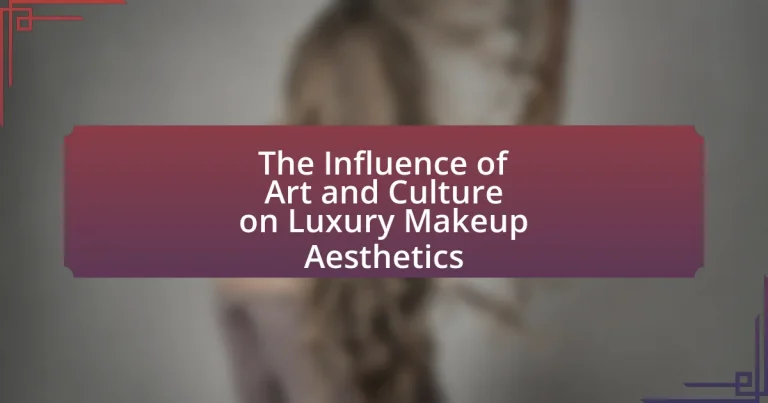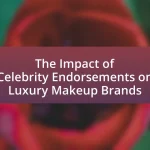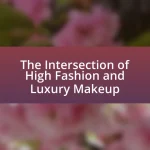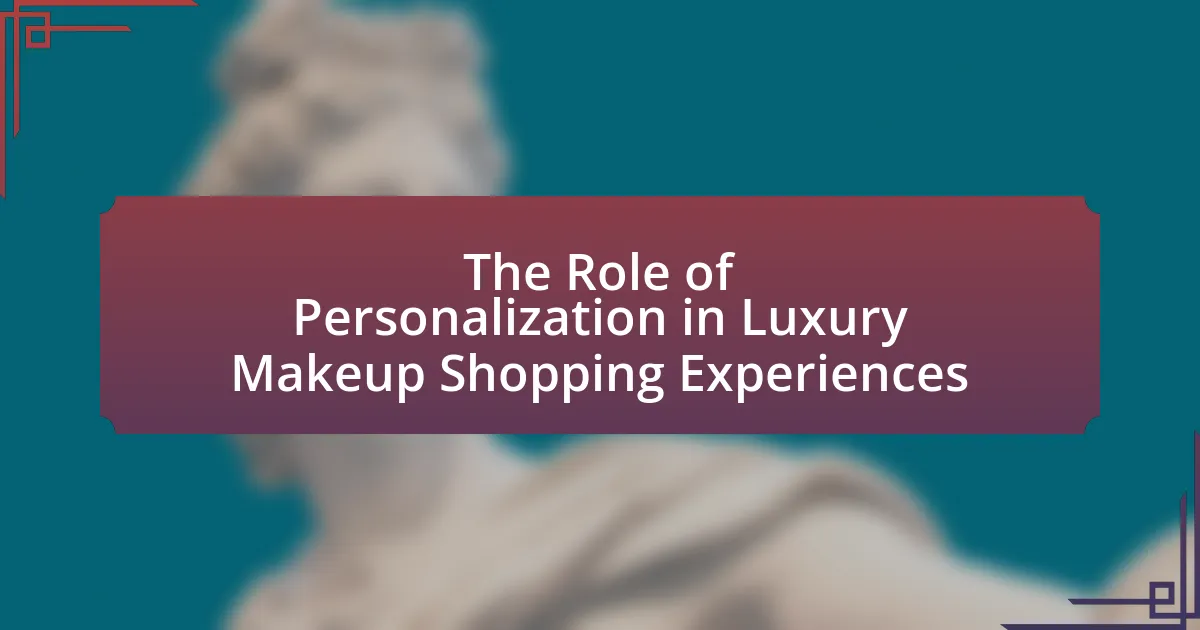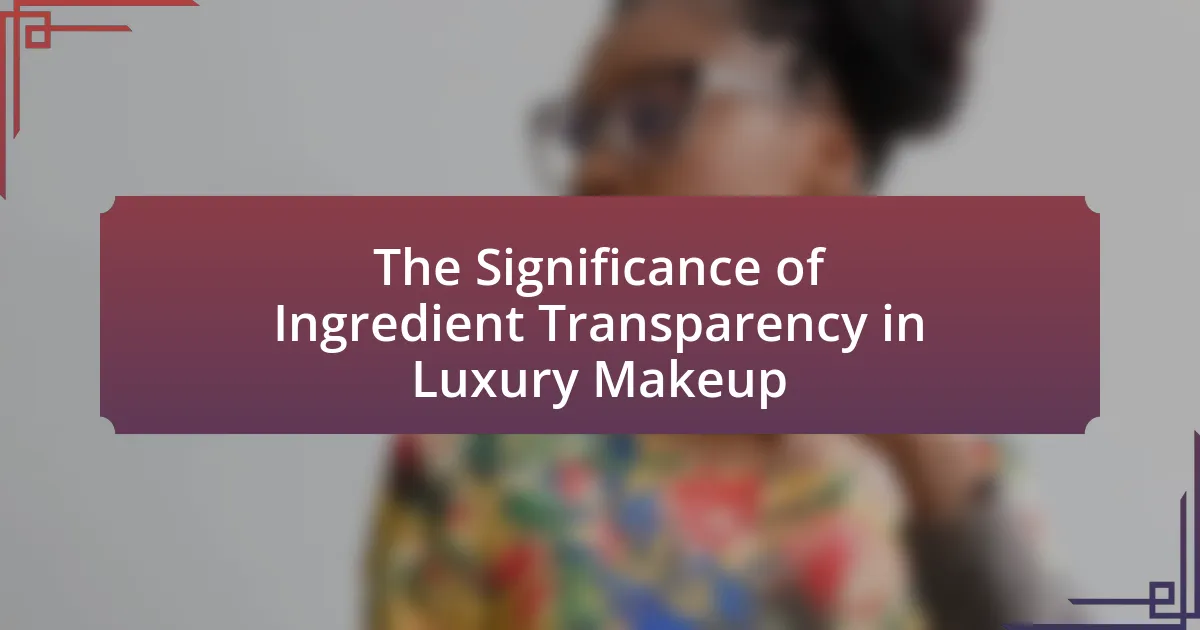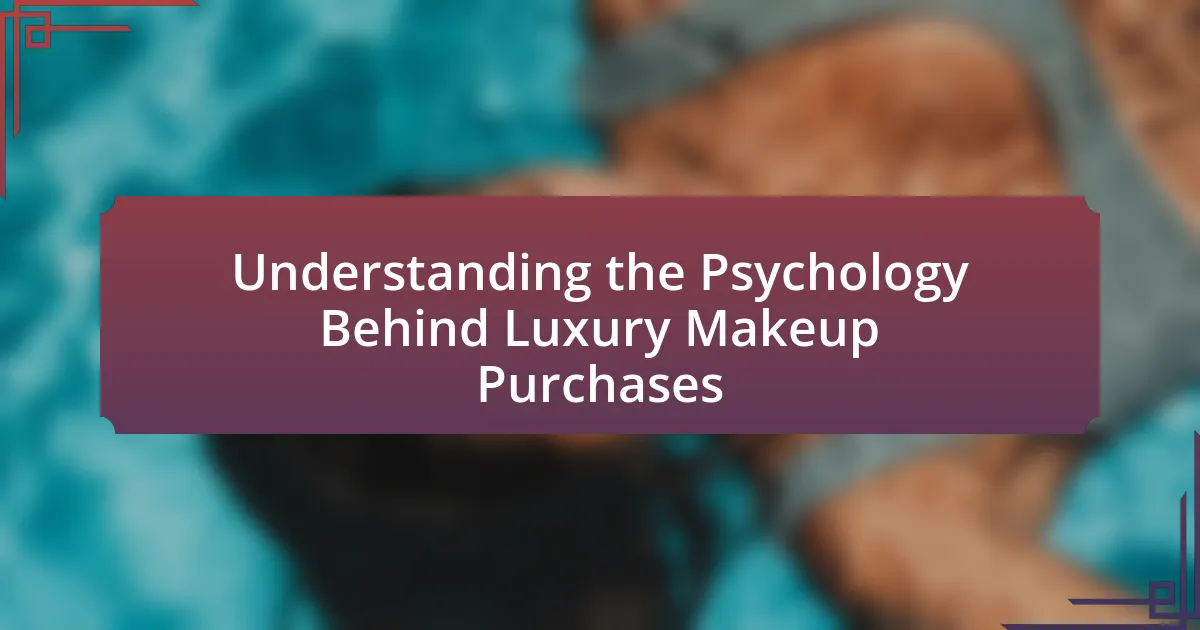The article examines the significant influence of art and culture on luxury makeup aesthetics, highlighting how various art movements, such as Impressionism and Pop Art, shape trends, color palettes, and product designs. It discusses the integration of cultural heritage into makeup, including the use of traditional beauty practices and symbols that resonate with diverse audiences. Additionally, the article explores the role of storytelling in branding, the impact of collaborations between artists and makeup brands, and emerging trends driven by technology and sustainability in the luxury makeup industry. Overall, it emphasizes the interplay between artistic expression and consumer engagement in shaping modern luxury makeup.

What is the Influence of Art and Culture on Luxury Makeup Aesthetics?
Art and culture significantly influence luxury makeup aesthetics by shaping trends, color palettes, and design elements. For instance, the Impressionist art movement has inspired makeup brands to create collections that reflect the soft, blended colors found in paintings by artists like Monet. Additionally, cultural events, such as fashion weeks and art exhibitions, often dictate seasonal makeup trends, as seen in the use of bold colors and intricate designs that mirror contemporary art styles. The integration of cultural symbols and motifs into packaging and product names further emphasizes this connection, as luxury brands often draw from diverse cultural heritages to appeal to a global audience. This interplay between art, culture, and luxury makeup not only enhances the visual appeal of products but also creates a narrative that resonates with consumers, making the aesthetics more meaningful and desirable.
How do art movements shape luxury makeup trends?
Art movements significantly shape luxury makeup trends by influencing color palettes, textures, and overall aesthetics. For instance, the Impressionist movement, characterized by its emphasis on light and color, has inspired makeup brands to create products that reflect soft, natural hues and luminous finishes. Similarly, the bold colors and graphic lines of the Pop Art movement have led to the development of vibrant lipsticks and eye shadows that embrace a playful, artistic flair. Historical examples include the collaboration between makeup brands and artists, such as the partnership between NARS and Andy Warhol, which directly draws from the visual language of his artwork. This interplay between art and makeup not only drives innovation but also allows consumers to express their individuality through artistic beauty.
What specific art styles have influenced makeup aesthetics?
Specific art styles that have influenced makeup aesthetics include Impressionism, Surrealism, and Pop Art. Impressionism, characterized by its focus on light and color, has inspired makeup looks that emphasize natural beauty and soft, blended tones. Surrealism, with its dreamlike and fantastical elements, has led to bold and unconventional makeup choices, often incorporating unexpected colors and shapes. Pop Art, known for its vibrant colors and graphic designs, has influenced makeup trends that embrace bright, playful hues and graphic eyeliner styles. These art movements have shaped the way makeup is conceptualized and applied, reflecting broader cultural trends and artistic expressions.
How do color palettes in art affect makeup product designs?
Color palettes in art significantly influence makeup product designs by guiding color selection and thematic coherence. Makeup brands often draw inspiration from prominent art movements, such as Impressionism or Pop Art, to create collections that resonate with current aesthetic trends. For instance, the use of vibrant colors in contemporary art can lead to the development of bold lipstick shades and eyeshadow palettes that reflect those hues. Additionally, color theory principles, such as complementary and analogous colors, are applied in makeup design to enhance the visual appeal and ensure harmony in product offerings. This connection is evident in collaborations between makeup brands and artists, where curated palettes mirror the artist’s signature style, thereby attracting consumers who appreciate both art and beauty.
In what ways does cultural heritage impact luxury makeup aesthetics?
Cultural heritage significantly impacts luxury makeup aesthetics by influencing color palettes, product formulations, and application techniques. For instance, traditional beauty practices from various cultures often dictate the use of specific colors that symbolize beauty or status, such as the use of red in Chinese culture for its auspicious connotations. Additionally, luxury brands often incorporate indigenous ingredients and formulations that reflect local customs, such as the use of argan oil in Moroccan beauty products. Furthermore, application techniques can be derived from cultural rituals, such as the intricate henna designs in South Asian cultures, which inspire makeup artistry. These elements collectively shape the visual and experiential aspects of luxury makeup, making it a reflection of cultural identity and heritage.
What cultural symbols are commonly represented in luxury makeup?
Cultural symbols commonly represented in luxury makeup include motifs such as floral patterns, animal imagery, and traditional art forms. These symbols often reflect the heritage and artistic traditions of specific cultures, enhancing the narrative and aesthetic appeal of the products. For instance, floral designs may symbolize beauty and femininity in various cultures, while animal motifs can represent strength or spirituality, as seen in brands that incorporate elements from Asian or Indigenous art. The use of these symbols not only connects consumers to cultural narratives but also elevates the luxury experience by embedding deeper meanings into the products.
How do traditional beauty standards influence modern luxury makeup?
Traditional beauty standards significantly influence modern luxury makeup by dictating the ideals of attractiveness that brands aim to embody and promote. These standards often emphasize features such as clear skin, symmetrical facial structures, and specific color palettes that align with cultural perceptions of beauty. For instance, luxury makeup brands frequently design products that enhance these features, such as foundations that provide flawless coverage and highlighters that accentuate bone structure, reflecting the longstanding ideals of beauty established in various cultures. Historical context shows that these standards have evolved but remain rooted in societal norms, as seen in the popularity of certain makeup styles that align with traditional aesthetics, such as the classic red lip or the emphasis on a contoured face. This alignment not only drives product development but also shapes marketing strategies, reinforcing the connection between traditional beauty ideals and contemporary luxury makeup offerings.
Why is the relationship between art, culture, and luxury makeup significant?
The relationship between art, culture, and luxury makeup is significant because it shapes aesthetic standards and influences consumer perceptions. Art provides inspiration for color palettes, textures, and design elements in luxury makeup, while cultural contexts dictate beauty ideals and trends. For instance, the use of bold colors in makeup can be traced back to various art movements, such as Impressionism, which emphasized vibrant hues. Additionally, cultural events like fashion weeks often showcase makeup artistry that reflects societal values and artistic expression, reinforcing the connection between these domains. This interplay not only enhances the appeal of luxury makeup but also drives innovation within the industry, as brands seek to resonate with diverse cultural narratives and artistic expressions.
What role does storytelling play in luxury makeup branding?
Storytelling plays a crucial role in luxury makeup branding by creating emotional connections between the brand and its consumers. This narrative approach enhances brand identity and differentiates products in a saturated market. For instance, luxury brands often weave tales of heritage, craftsmanship, and artistry into their marketing, which resonates with consumers seeking authenticity and exclusivity. Research indicates that brands that effectively utilize storytelling can increase customer loyalty and engagement, as narratives evoke feelings and foster a sense of belonging. This strategy is evident in campaigns that highlight the inspiration behind product lines, such as the use of historical art movements or cultural motifs, which not only enrich the brand’s image but also elevate the consumer experience.
How does consumer perception of art and culture affect luxury makeup sales?
Consumer perception of art and culture significantly influences luxury makeup sales by shaping brand identity and consumer preferences. When consumers associate luxury makeup brands with high art and cultural significance, they are more likely to perceive these products as exclusive and desirable. For instance, collaborations between makeup brands and renowned artists or cultural icons can enhance the perceived value of the products, leading to increased sales. A study by the Journal of Business Research found that consumers are willing to pay a premium for products that reflect artistic value, indicating that a strong connection to art and culture can drive purchasing decisions in the luxury makeup market.
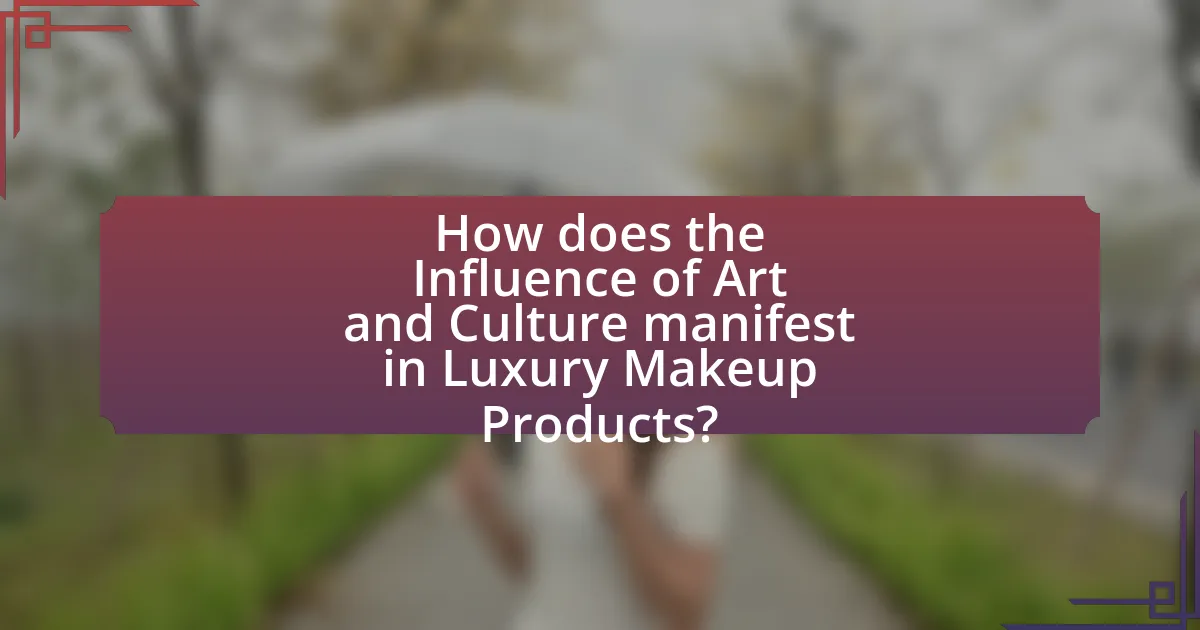
How does the Influence of Art and Culture manifest in Luxury Makeup Products?
The influence of art and culture manifests in luxury makeup products through the incorporation of artistic designs, cultural symbolism, and collaborations with renowned artists. Luxury brands often draw inspiration from various art movements, such as Impressionism or Surrealism, to create visually striking packaging and product designs that reflect these styles. For instance, brands like Yves Saint Laurent have released collections inspired by famous artworks, integrating iconic imagery into their product aesthetics. Additionally, cultural elements are frequently embedded in product names, colors, and marketing campaigns, allowing brands to resonate with diverse consumer backgrounds. This approach not only enhances the visual appeal of the products but also creates a narrative that connects consumers to the broader cultural context, exemplified by limited-edition collections that celebrate specific cultural festivals or artistic heritage.
What are the key elements of luxury makeup influenced by art and culture?
The key elements of luxury makeup influenced by art and culture include innovative packaging design, color palettes inspired by artistic movements, and collaborations with renowned artists. Innovative packaging often reflects artistic aesthetics, enhancing the overall luxury experience; for example, brands like Yves Saint Laurent have utilized iconic art styles in their product designs. Color palettes are frequently derived from significant art movements, such as Impressionism or Surrealism, allowing consumers to engage with cultural history through makeup; for instance, the use of vibrant colors reminiscent of Van Gogh’s paintings in certain collections. Collaborations with artists, such as the partnership between MAC Cosmetics and various contemporary artists, further integrate cultural narratives into luxury makeup, creating products that are not only functional but also serve as collectible art pieces. These elements collectively elevate luxury makeup by intertwining beauty with cultural significance and artistic expression.
How do packaging designs reflect artistic influences?
Packaging designs reflect artistic influences by incorporating visual elements, color schemes, and stylistic choices that resonate with specific art movements or cultural aesthetics. For instance, luxury makeup brands often draw inspiration from Impressionism, Art Deco, or contemporary art, using bold colors and geometric shapes to evoke the essence of these styles. A notable example is the collaboration between a luxury makeup brand and a renowned artist, which resulted in packaging that mirrors the artist’s signature techniques and themes, thereby enhancing the product’s appeal and perceived value. This alignment with artistic trends not only attracts consumers but also positions the brand within a broader cultural context, reinforcing its identity and market differentiation.
What ingredients are inspired by cultural practices in luxury makeup?
Ingredients inspired by cultural practices in luxury makeup include saffron, rice powder, and traditional herbal extracts. Saffron, used in Middle Eastern beauty rituals, is known for its skin-brightening properties. Rice powder, rooted in Asian beauty traditions, serves as a natural mattifier and exfoliant. Additionally, herbal extracts like neem and turmeric, prominent in Indian skincare, are celebrated for their anti-inflammatory and healing benefits. These ingredients reflect the integration of cultural heritage into luxury makeup formulations, enhancing both efficacy and aesthetic appeal.
How do collaborations between artists and makeup brands enhance aesthetics?
Collaborations between artists and makeup brands enhance aesthetics by merging creative vision with cosmetic innovation, resulting in unique product offerings that reflect artistic expression. These partnerships often lead to limited-edition collections that incorporate distinctive colors, packaging designs, and themes inspired by the artist’s work, thereby elevating the visual appeal of the products. For instance, the collaboration between makeup brand MAC and artist Keith Haring introduced vibrant colors and iconic graphics, which not only attracted art enthusiasts but also created a visually striking product line that stood out in the market. Such collaborations leverage the artist’s established aesthetic to create a narrative around the makeup, enhancing its desirability and cultural relevance.
What are some notable collaborations in the luxury makeup industry?
Notable collaborations in the luxury makeup industry include the partnership between Pat McGrath and various fashion houses, such as her work with Valentino, which showcased innovative makeup looks on the runway. Another significant collaboration is the collaboration between Dior and artist Kaws, resulting in limited-edition packaging that merges high fashion with contemporary art. Additionally, the collaboration between Fenty Beauty and various influencers has redefined inclusivity in makeup, emphasizing diverse skin tones. These collaborations highlight the intersection of art, culture, and luxury in makeup aesthetics, driving trends and consumer engagement.
How do these collaborations impact consumer engagement?
Collaborations between luxury makeup brands and artists or cultural figures significantly enhance consumer engagement by creating unique, limited-edition products that resonate with specific audiences. These partnerships often leverage the artist’s or cultural figure’s following, resulting in increased visibility and interest in the brand. For instance, collaborations like those between MAC Cosmetics and various artists have historically led to a 20% increase in sales during the launch period, demonstrating a direct correlation between such partnerships and heightened consumer interaction. Additionally, these collaborations often incorporate storytelling elements that connect emotionally with consumers, fostering a sense of community and loyalty towards the brand.
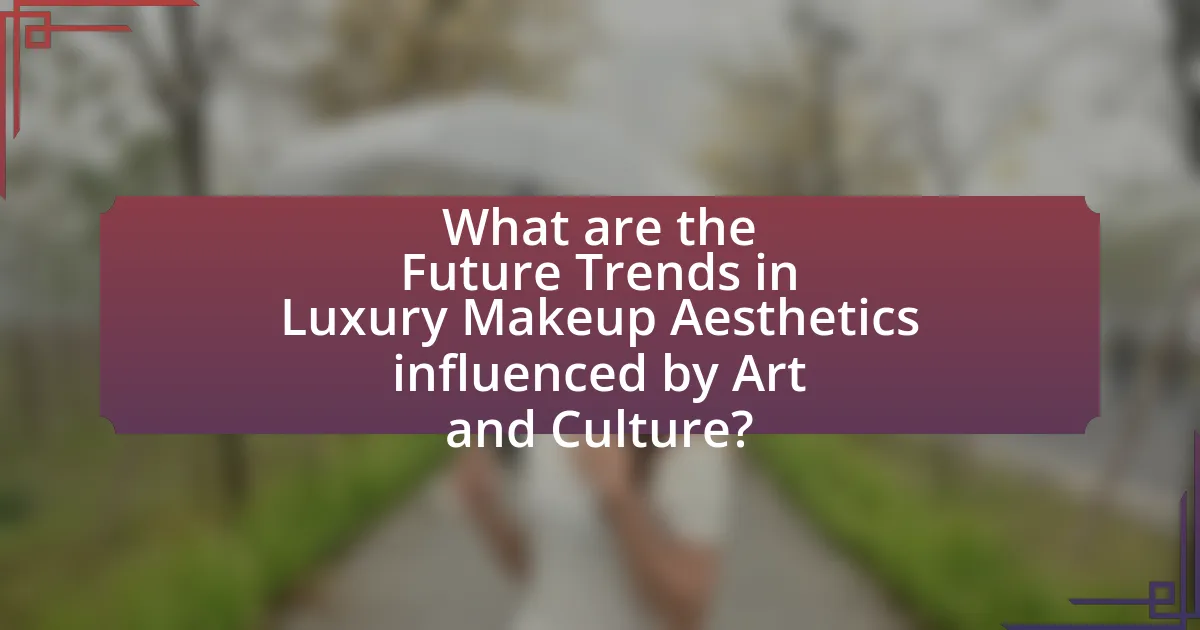
What are the Future Trends in Luxury Makeup Aesthetics influenced by Art and Culture?
Future trends in luxury makeup aesthetics influenced by art and culture include a significant shift towards sustainability, personalization, and the integration of digital technology. Brands are increasingly adopting eco-friendly practices, such as using biodegradable packaging and natural ingredients, reflecting a cultural emphasis on environmental responsibility. Personalization is becoming prominent, with consumers seeking unique products tailored to their individual preferences, often inspired by diverse cultural aesthetics. Additionally, the rise of augmented reality and virtual try-on technologies is transforming the shopping experience, allowing consumers to engage with makeup in innovative ways. These trends are supported by market research indicating that 70% of consumers are willing to pay more for sustainable products, and the global augmented reality in retail market is projected to reach $61.4 billion by 2023.
How is technology shaping the intersection of art, culture, and luxury makeup?
Technology is significantly shaping the intersection of art, culture, and luxury makeup by enabling innovative tools and platforms that enhance creativity and accessibility. Digital applications, such as augmented reality (AR) and artificial intelligence (AI), allow consumers to virtually try on makeup, bridging the gap between artistic expression and consumer experience. For instance, brands like L’Oréal and Sephora utilize AR technology to provide personalized makeup trials, reflecting cultural trends and artistic styles in real-time. Additionally, social media platforms facilitate the rapid dissemination of beauty trends, allowing diverse cultural influences to merge and inspire luxury makeup aesthetics. This integration of technology not only democratizes access to luxury makeup but also fosters a dynamic dialogue between artists, consumers, and brands, ultimately reshaping the landscape of beauty and self-expression.
What innovations are emerging from the fusion of art and makeup technology?
Innovations emerging from the fusion of art and makeup technology include augmented reality (AR) applications that allow users to visualize makeup looks in real-time, as well as the development of smart makeup tools that analyze skin tone and texture for personalized application. These advancements are supported by the increasing integration of digital art techniques in makeup design, enabling artists to create intricate, customizable looks that can be easily shared and replicated. For instance, brands like L’Oréal and Sephora have implemented AR technology in their apps, enhancing customer engagement and providing a more interactive shopping experience.
How do social media platforms influence trends in luxury makeup aesthetics?
Social media platforms significantly influence trends in luxury makeup aesthetics by enabling rapid dissemination of visual content and fostering community engagement. Platforms like Instagram and TikTok allow beauty influencers and brands to showcase makeup looks, tutorials, and product launches, which can quickly go viral and shape consumer preferences. For instance, a study by the Journal of Business Research found that user-generated content on social media increases brand engagement and drives purchasing decisions, particularly in the beauty sector. This dynamic creates a feedback loop where trends can emerge and evolve in real-time, reflecting the collective tastes and aspirations of users.
What practical tips can consumers use to embrace art and culture in their makeup choices?
Consumers can embrace art and culture in their makeup choices by selecting products inspired by diverse artistic movements and cultural traditions. For instance, they can explore makeup lines that collaborate with artists or are influenced by specific art styles, such as Impressionism or African tribal art, which often incorporate vibrant colors and unique patterns. Additionally, consumers can attend local art exhibitions or cultural festivals to gain inspiration and discover makeup brands that celebrate these themes. Research shows that brands like Fenty Beauty and NARS often draw from cultural influences, reflecting a broader trend in the luxury makeup industry that values artistic expression. By actively seeking out these connections, consumers can enhance their makeup routines with meaningful cultural narratives.
How can consumers identify culturally inspired makeup products?
Consumers can identify culturally inspired makeup products by examining the packaging, ingredients, and marketing narratives that reflect specific cultural elements. For instance, brands often incorporate traditional motifs, colors, and symbols from particular cultures into their product designs, which can signal cultural inspiration. Additionally, the use of ingredients that are significant to certain cultures, such as indigenous botanicals, can further indicate a product’s cultural roots. Research shows that brands like Fenty Beauty and Huda Beauty have successfully integrated cultural references into their product lines, appealing to diverse consumer bases while respecting cultural heritage.
What are the best practices for selecting makeup that reflects personal artistic preferences?
The best practices for selecting makeup that reflects personal artistic preferences include understanding color theory, experimenting with different textures, and considering individual skin tone and undertones. Color theory helps individuals choose shades that complement their artistic vision, while experimenting with textures like matte, shimmer, or glossy can enhance the overall aesthetic. Additionally, selecting shades that align with one’s skin tone ensures that the makeup enhances rather than detracts from the desired artistic expression. These practices are supported by the principles of color harmony and the psychology of color, which emphasize the importance of color choices in artistic representation.
